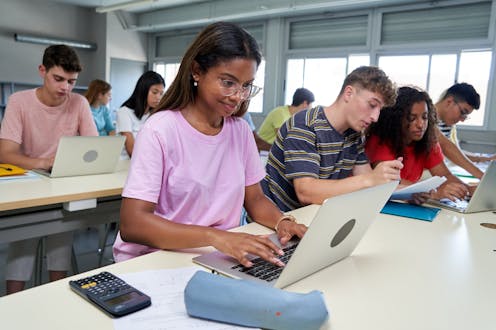Detta inlägg post publicerades ursprungligen på denna sida this site ;
Date:
Author: Rss error reading .
Original article: https://theconversation.com/why-we-need-to-teach-digital-literacy-in-schools-253497

In the modern world, screens are everywhere, from our classrooms and workplaces to our homes and pockets. For children and teenagers, they can be a window to learning, enjoyment and connection with the world. Too much screen time, however, can have serious consequences.
Adults spend, on average, between six and seven hours per day in front of screens. In Spain, like much of Europe, children and teenagers spend more than three hours per day looking at screens, though this figure can double at weekends.
Such intense exposure has obvious problems, such as taking time from other beneficial activities like sport or socialising in person. It also has negative health impacts, ranging from from short-sightedness, headaches and musculoskeletal disorders to shorter attention spans and delays in the development of children’s problem solving and communication skills.
Beyond the impacts of social media on young people’s mental health, the ubiquity of screens is prompting many families and teachers to wonder whether education without technology, or at least with less screen time, would be better.
However, we also need to teach children how to deal with the internet and how to work with technology. Training young people in digital skills, such as critical thinking and cybersecurity, is essential to keeping them safe online.
In addition, digital platforms such as Google Classroom, Duolingo and Kahoot! have revolutionised learning, making it both more convenient and more personalised in the classroom and at home.
Leer más:
Kids and the internet: how our new tool assesses children’s ’digital maturity’
Balance is possible
Schools around the world are finding ways to balance the risks and benefits of technology in the classroom. One inspiring success story is that of a school in Finland that implemented a hybrid model combining digital learning with hands-on activities. As a result, students improved their academic performance and developed advanced technological skills.
Other successful examples – such as the “Abraza tus valores” (Embrace your values) and “Párate a pensar” (Stop to think) programmes by Aldeas Infantiles SOS in Spain – promote the balanced use of technology among young people.
The United States also boasts programmes such as that developed by The Step by Step School. This initiative emphasises the moderate and purposeful use of technology by incorporating educational apps that support children’s development and encourage creativity, setting clear limits for screen time, and promoting off-device activities such as outdoor play and hands-on projects.
A question of equity
Screens can provide access to knowledge and make our lives easier, but we cannot allow them to become a substitute for real human experiences. Digital education should be complemented by activities that develop social, emotional and physical skills.
The solution to excessive screen use is not saying goodbye to technology in the classroom altogether. Ignoring these technological tools in education would deprive students of the skills they need to function in an increasingly interconnected world. Instead, we have to make sure they are used to their full potential.
In Spain, 70% of children between the ages of 10 and 15 own a smartphone, with similar or higher figures reported across the EU. While these figures are high, they only give us half of the picture. Smartphones are tools, and like any tool, knowing how to use it properly and safely is vital.
Children, like many adults, use the internet and social media uncritically. Being mere consumers of what the internet offers can seriously limit their capacity for social integration.
This aspect of the digital divide is where schools can level the playing field by providing access to technological resources and promoting equity of opportunity. By implementing digital literacy programmes, they can ensure that all students, regardless of their socio-economic background, have an equal opportunity to succeed.
This is a collective challenge, and parents, teachers and young people must all work together to build healthy, conscious habits. To do this, we have to answer crucial questions about how we use our time in front of screens, and how we can reap technology’s benefits without falling prey to its risks. At the end of the day, the goal is not to live without screens, but to learn to live with them in a smart way.
![]()
Pedro Adalid Ruíz no recibe salario, ni ejerce labores de consultoría, ni posee acciones, ni recibe financiación de ninguna compañía u organización que pueda obtener beneficio de este artículo, y ha declarado carecer de vínculos relevantes más allá del cargo académico citado.

